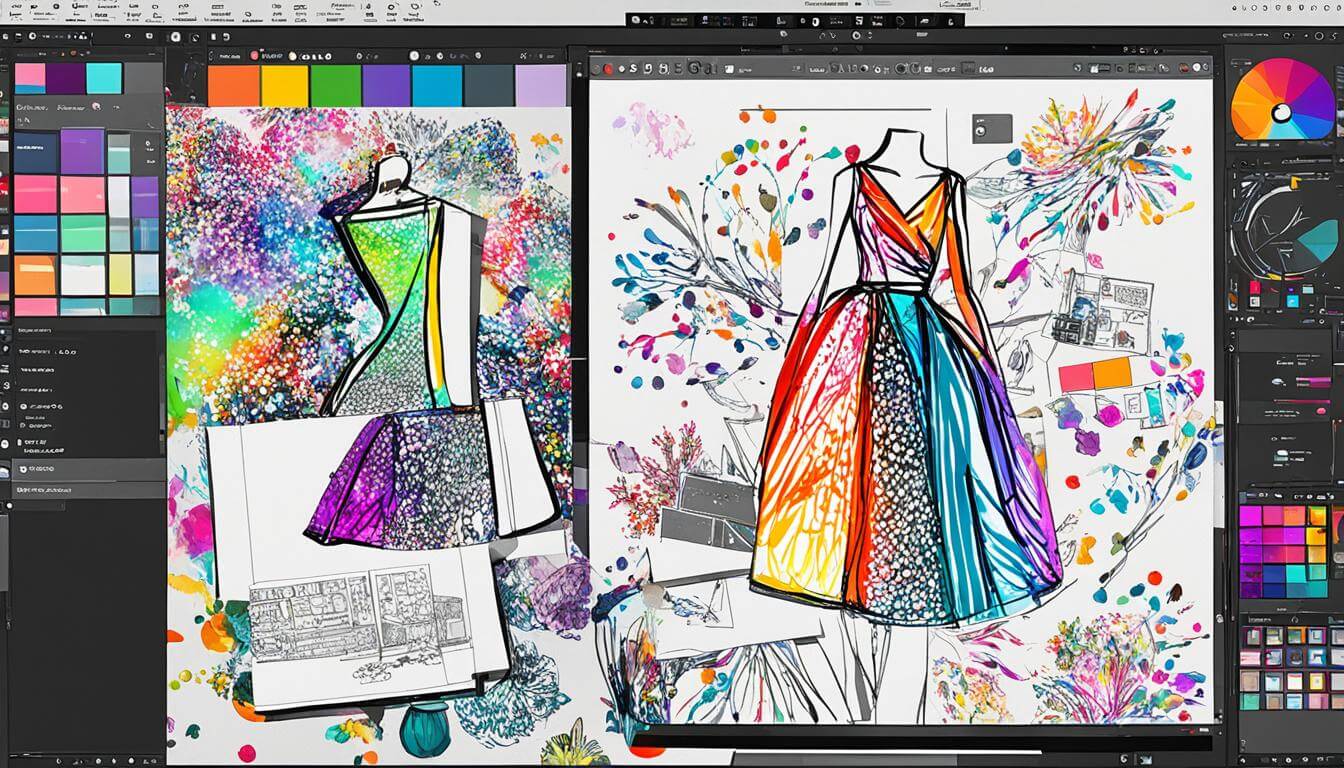Hey, you! Are you ready to dive into the fascinating world of 3D scanning? Let’s start with the basics. Point cloud scanning is a technique used to create accurate 3D models of objects and environments. It involves using laser scanning and lidar technology to collect point cloud data, which is essentially a collection of 3D points that represent the surface of an object or space.
Point cloud scanning has become an essential tool in various industries, from architecture and engineering to film and gaming. This technology enables professionals to create detailed and precise models that can be used for visualization, analysis, and simulation. So, whether you’re a designer, engineer, archaeologist, or just a curious tech enthusiast, point cloud scanning is definitely worth exploring.
Key Takeaways:
- Point cloud scanning is a technique used to create accurate 3D models of objects and environments
- Laser scanning and lidar technology are used to collect point cloud data
- Point cloud scanning is essential in various industries such as architecture, engineering, and film
Delving into Point Cloud Scanning
Buckle up, because we’re about to take a deep dive into the fascinating world of point cloud scanning! One of the most important aspects of this technology is point cloud visualization, which helps you create detailed 3D representations of the objects and environments you’re scanning.
Think of it like painting an incredibly intricate picture, except instead of a brush and canvas, you’re using lasers and lidar to collect information about the physical world. That raw data is then processed through point cloud software to create stunning visualizations that can be analyzed and manipulated in a variety of ways.
But don’t get too carried away with the pretty pictures just yet, because we also need to talk about point cloud processing. This is where the real magic happens – taking all that raw data and turning it into something useful. We’re talking about noise removal, scan merging, and data alignment – all the technical stuff that makes point cloud scanning possible!
Visualization Matters
Before we get to the nitty-gritty of processing, let’s talk a bit more about point cloud visualization. This is where you really get to see the fruits of your labor. With the right tools and techniques, you can render incredibly detailed 3D models that allow you to explore your data in ways that would be impossible with traditional 2D images.
One of the coolest things about point cloud visualization is that it lets you see things that might not be immediately obvious from a flat image. You can rotate the model, zoom in and out, and examine it from every angle to get a more comprehensive understanding of the object or environment you’re scanning.
Processing: The Unsung Hero
Of course, none of this would be possible without point cloud processing. This is where the real heavy lifting happens, as your raw data is transformed into coherent 3D models that can be analyzed and manipulated.
The process can be complex, but it’s absolutely essential for getting accurate results. You need to remove noise, merge scans together, and achieve proper data alignment – all tasks that require sophisticated algorithms and careful attention to detail.
But when it’s all said and done, you’re left with a stunning 3D model that can be used for a wide range of applications. Whether you’re working in architecture, engineering, or any other field that requires precise measurements and detailed analysis, point cloud scanning is an absolute game-changer.
Unleashing the Power of Point Cloud Data
So you’ve collected all this point cloud data, but what can you actually do with it? The applications of point cloud data are vast and span across multiple industries. From architecture to archaeology, the possibilities are endless.
One of the most important aspects of point cloud analysis is the ability to extract valuable insights. By analyzing the data, you can make more informed decisions, improve accuracy, and save time and money. Imagine being able to measure distances and dimensions from your computer screen without ever having to visit a physical location!
Architects and engineers use point cloud data to create accurate 3D models of buildings, which can be used for renovations, repairs, and redesigns. Point cloud analysis can also be used for object recognition, such as identifying and classifying machinery parts for maintenance purposes.
But the applications don’t stop there. Point cloud data is also used in the entertainment industry to create realistic virtual reality environments, and in the medical industry to create 3D models of organs for surgical planning.
As technology continues to advance, the applications of point cloud data will only continue to expand. Who knows what exciting possibilities the future holds?
The Role of Laser Scanning in Point Cloud Scanning
Now it’s time to take a closer look at the secret sauce behind point cloud scanning: laser scanning. This technology is what makes it all possible, so let’s dive in.
Laser scanning is a non-contact, non-destructive way to measure and capture data about physical objects and environments. It works by emitting laser beams that bounce off surfaces and return to a sensor, creating a 3D map of the space.
The accuracy of laser scanning is what sets it apart from other methods of data capture. It can measure objects down to the millimeter, capturing even the smallest details and nuances of a surface. Plus, laser scanners are becoming faster and more efficient, making it possible to capture larger areas in less time.
So, if you want to take your point cloud scanning game to the next level, you need to learn more about laser scanning.
“With laser scanning, you can capture data with speed, accuracy and convenience – leaving you more time to sit back, relax, and enjoy a cup of coffee.”
Point Cloud Visualization: Bringing Data to Life
Have you ever looked at a dense set of data and struggled to make sense of it all? Welcome to the world of point cloud data visualization! But fear not, my friend. With the right tools and techniques, you can transform complicated data sets into visually appealing and easily understandable representations.
The process of point cloud visualization involves rendering the raw data into a 3D image or model, enabling you to explore, analyze, and manipulate it in a way that was previously impossible. By harnessing the power of point cloud visualization, you can make informed decisions, spot patterns, and gain new insights into the data that you may have missed otherwise.
One of the key benefits of point cloud visualization is in the realm of architecture and design, where it is used to develop realistic 3D models of buildings and structures. With tools such as point cloud stitching and mesh generation, you can create accurate models of any structure, enabling you to experiment with different design elements and materials with ease.
But point cloud visualization is not limited to just architecture and design. It is also used in engineering, transportation, and even entertainment. With the rise of virtual and augmented reality technologies, point cloud data can be used to create immersive and realistic virtual environments for gaming, training simulations, and more.
So go forth and unleash your creativity with the power of point cloud visualization. With the right techniques and tools at your disposal, you can turn data into art and revolutionize the way you analyze and interpret information.
Processing Point Cloud Data: Transforming Raw Output
Ready to transform those raw point cloud scans into stunning 3D models? Let’s dive into the nitty-gritty of point cloud processing.
First things first, you’ll need specialized software to process the data. There are a plethora of options available, each with their own unique features and capabilities. Some popular choices include Autodesk ReCap, Bentley Pointools, and Leica Cyclone.
Once you have your software in hand, you can start by removing any unwanted noise from the point cloud data. This is done using algorithms that filter out any extraneous points that might skew your results.
Next, it’s time to merge multiple scans into a single point cloud. This can be a tricky process, as it involves aligning the individual scans to create a seamless and accurate 3D model. Luckily, most point cloud processing software includes tools that make this step a breeze.
Finally, with your scans aligned and your noise removed, you’re ready to generate your 3D model. This is where the real magic happens, as your software uses sophisticated algorithms to turn the point cloud data into a photorealistic representation of your target object or environment.
It’s worth noting that point cloud processing can be a time-consuming process, particularly for large or complex data sets. However, the end result is well worth the effort, as you’ll be left with an accurate and highly-detailed 3D model that can be used for a variety of applications.
Analyzing Point Cloud Data: Unlocking Insights
So, you’ve collected a massive amount of point cloud data. Now what? Time to analyze and extract insights that could change the game. With point cloud analysis, you can do just that.
Measurement, object recognition, and even virtual reality applications are just a few examples of how point cloud analysis can be applied. No need for complicated measurements, just sit back and let the technology do the work.
And if you thought it couldn’t get any better, think again! Point cloud analysis can help you identify patterns and trends that might otherwise go unnoticed. Talk about a game-changer!
Unlocking insights with point cloud analysis
| Application | Benefits |
|---|---|
| Measurement | Accurate and efficient measurements without the need for manual calculations. |
| Object Recognition | Efficient identification and tracking of objects in a given space. |
| Virtual Reality | Creating immersive and interactive experiences that feel like the real thing. |
Get ready to unlock the full potential of your point cloud data and gain valuable insights that can help you make informed decisions.
The possibilities with point cloud analysis are endless. With the right software and tools, you can turn raw data into a treasure-trove of information. So, what are you waiting for? Dive deep and start analyzing your point cloud data today!
Point Cloud Software: Tools of the Trade
Now that you’re a point cloud scanning expert, it’s time to explore the software options available to bring your 3D imaging to life. These tools are essential for processing, analyzing, and visualizing your point cloud data.
One industry-leading software is Autodesk’s ReCap, which offers advanced point cloud processing, registration, and cleanup tools. Another option is Bentley’s ContextCapture, which provides automated point cloud processing and visualization for efficient workflows. And let’s not forget about CloudCompare, an open-source point cloud processing software that won’t break the bank.
But wait, there’s more! Point cloud software is constantly evolving and new tools are emerging. Take a look at Pix4Dmapper, a software that specializes in point cloud generation from photogrammetry. Or try out MeshLab, a versatile point cloud and mesh processing tool for 3D printing and visualization.
With so many options out there, it’s important to find the software that best fits your needs and budget. So, get ready to dive in and explore the world of point cloud software!
Point Cloud Scanning: Revolutionizing Industries
Point cloud scanning is not just a technology, it’s a revolution. Its impact has been felt across industries, from engineering and construction to archaeology and beyond.
If you are in any of these industries, you know how important it is to have accurate and detailed 3D models, and that’s where point cloud scanning comes to the rescue. Point cloud scanning has enabled us to capture real-world data quickly and accurately, which can then be used for a variety of applications.
One of the most significant applications of point cloud scanning is in architecture and construction. Point cloud scanning allows architects and engineers to create 3D models of existing structures, which can be used for renovation or restoration projects. This technology is also being used to monitor construction sites and ensure that projects are on track.
Another industry that has been transformed by point cloud scanning is archaeology. Archaeologists can now use point cloud scanning to create highly detailed 3D models of artifacts, structures, and even entire sites. This has allowed them to uncover new insights into ancient cultures and has helped in the preservation of historical sites.
| Industries transformed by Point Cloud Scanning | Applications of Point Cloud Scanning |
|---|---|
| Architecture | Renovation and Restoration, Construction Site Monitoring |
| Engineering | Product Design and Development, Machine Alignment |
| Construction | Quality Control, As-Built Surveying |
| Archaeology | Artifact and Site Analysis, Preservation |
Point cloud scanning has also transformed industries such as product design and development, where it is used to create 3D models of products for prototyping and testing. In engineering, point cloud scanning is used for machine alignment and quality control. And in construction, point cloud scanning is used for as-built surveying and quality control.
As you can see, the applications of point cloud scanning are vast and varied. It has become an essential tool in many industries, enabling us to work more efficiently, accurately, and creatively.
So why not join the point cloud scanning revolution and see how it can transform your industry?
The Future of Point Cloud Scanning
What does the future hold for point cloud scanning? Buckle up, because it’s going to be a wild ride. As technology continues to advance at breakneck speed, the possibilities for point cloud scanning are endless.
One of the most exciting areas of development is the integration of point cloud data with artificial intelligence and machine learning. These powerful tools will allow for even more accurate and efficient analysis of point cloud data, opening up new opportunities for insights and discoveries.
Another area of growth is in the use of point cloud data for virtual and augmented reality applications. Imagine being able to explore and interact with 3D models in real time, with a level of detail and accuracy never before possible.
As point cloud scanning becomes more widespread and accessible, we can also expect to see it being used in new industries and sectors. From healthcare to entertainment, the possibilities are endless.
Of course, with any new technology, there will be challenges and obstacles to overcome. One of the biggest barriers to wider adoption of point cloud scanning is the cost of the equipment and software. But as the technology becomes more popular and demand increases, we can expect prices to come down.
So what does all this mean for you? It means that if you’re not already exploring the world of point cloud scanning, now is the time to start. Get ahead of the curve and start experimenting with this exciting technology today.
Who knows what the future holds, but one thing is for sure, the world of point cloud scanning is only going to get bigger and better.
Join the Point Cloud Scanning Revolution!
So, you’ve made it to the end of this article! Congratulations, you’re now a certified expert in all things point cloud scanning. Just kidding, but you do have a pretty good idea of what it is and how it can benefit your industry.
If you’re not already utilizing point cloud scanning in your work, what are you waiting for? It’s time to join the revolution! Say goodbye to tedious manual measurements and hello to accurate, detailed 3D models.
By embracing point cloud scanning, you’ll be at the forefront of technological advancements in your industry. Who knows what amazing possibilities lie ahead in the world of 3D imaging and point cloud scanning? By staying up to date with the latest trends and developments, you’ll be sure to be at the forefront of any new breakthroughs.
So, what are you waiting for? Dive into the world of point cloud scanning and unlock its potential in your industry. You won’t regret it!









Comments 1
Comments are closed.